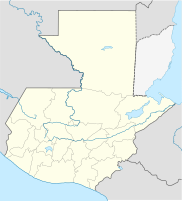Santa Lucía Cotzumalguapa
| Santa Lucía Cotzumalguapa | ||
|---|---|---|
|
Coordinates: 14 ° 20 ′ N , 91 ° 1 ′ W Santa Lucía Cotzumalguapa on the map of Guatemala
|
||
| Basic data | ||
| Country | Guatemala | |
| Department | Escuintla | |
| Residents | 45,000 | |
| City insignia | ||
| Detailed data | ||
| height | 372 m | |
| Time zone | UTC −6 | |
| Santa Lucía Cotzumalguapa - Church | ||
Santa Lucía Cotzumalguapa is a city of about 45,000 people in southwest Guatemala . The so-called Cotzumalhuapa culture with the main sites El Baúl and Bilbao is named after her. Until a fire in 1715, the city was called Santiago Cotzumalguapa; Many churches and places in Central and South America were consecrated to the Apostle James , the patron saint of Spanish knights during the Reconquista . The name was later changed in honor of the patron saint Lucia of Syracuse .
Location and climate
Santa Lucía Cotzumalguapa is located at an altitude of about 370 m above sea level. d. M. and is about 86 km (driving distance) in a south-westerly direction from the state capital Guatemala City and about 25 km from the departmental capital Escuintla in the east. About 40 km as the crow flies or 75 km drive separate the city from Puerto San José on the Pacific , which is responsible for the humid climate. In the background, the landscape is dominated by the volcanic mountains of the highlands, especially the Fuego volcano , which is often active and spews out mineral-rich ash clouds.
economy
There are extensive sugar cane plantations in the vicinity of the city , which provide year-round yield. Cutting the sugar cane with the help of machetes is still laborious manual labor; Forklift trucks and trucks are only used for loading and transporting the 2 to 4 m long sugar cane poles. From the molasses , a thick brown waste product in the refining process of sugar cane juice, clear alcohol is distilled , which then matures into brown rum over years in used sherry or whiskey barrels made of oak wood ; the white rum ( Bacardi ), on the other hand, is stored in metal tanks.
history
As the archaeological finds on the 3 to 5 km north located Fincas El Baúl and Bilbao show, the surrounding area was already populated in pre-Columbian times. During the late classical period (approx. 600–900 AD) the Cotzumalhuapa culture reached its climax. Possibly their influence extended to Cara Sucia in El Salvador . Around the year 1000, the place was abandoned by its inhabitants, albeit not completely.
In 1866, a large number of stone artefacts were discovered on the area of the former coffee plantations El Baúl and Bilbao, some of which found their way into museums, including the Ethnological Museum in Berlin, a few years later .
Attractions
- The town's church certainly dates back to after 1715, when a fire ravaged the city. Its facade consists of a well-balanced middle section with side towers, which were mainly used for stabilization. While the towers - as usual - have an unadorned design in the lower part, the façade is structured by vertical columns, the lower ones of which are turned against each other in pairs, and by richly profiled horizontal cornices. The facade ends in a baroque gable with an attached cross, which can also be found on the two bell houses of the towers. The niches contain figures of saints, including St. Lucia in the middle of the pediment. The single-nave nave ends in a domed choir area.
- For the residents of the village and its surroundings, the church facade is less of interest than the life-size cross-bearing Passion figure of Jesus Nazareno , which can be seen all year round in a side chapel of the church. The suffering, but still clad in a richly embroidered red cloak, is pleaded for help by many believers. During Holy Week ( semana santa ), it is carried in a procession through the streets of the city. The expressive figure probably dates from the late Baroque period; some damage caused by the fire in the church has been restored and is hidden under the mantle.
- On the site of the former Finca Bilbao , approx. 1.5 km north of the city, there are still 3 monumental stones in relief.
- The Finca El Baul is located approximately 3.5 km north of the city; Their open-air museum, established in the 1990s, houses some of the most important archaeological finds of the Cotzumalhuapa culture. A few pre-Columbian monuments, including a perfectly carved monumental head of an old man (or god) with a pronounced hooked nose and a sacrificial stone are still in the middle of the sugar cane fields and are worshiped by the Indians with candles, flowers and alcohol.




